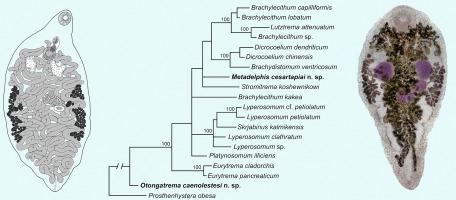Parasitology International ( IF 1.5 ) Pub Date : 2020-05-16 , DOI: 10.1016/j.parint.2020.102138 Tyler J Achatz 1 , Dawn W Cleveland 1 , Carlos Carrión Bonilla 2 , Lawrence Cronin 1 , Vasyl V Tkach 1

|
The Dicrocoeliidae is a highly diverse and broadly distributed family of digeneans typically parasitic in the gall bladder and liver of their tetrapod hosts. So far, no study has reported dicrocoeliids, or any digeneans, from the ancient marsupial family Caenolestidae. Herein, we describe a new genus of dicrocoeliids (Otongatrema n. gen.) from Tate's shrew opossum Caenolestes fuliginosus and a new species of Metadelphis (Metadelphis cesartapiai n. sp.) from a phyllostomid bat Anoura peruana collected in Ecuador. Otongatrema can be readily distinguished from the morphologically closest dicrocoeliid genera Concinnum, Conspicuum and Canaania based on the position of the genital pore, distribution/position of the uterus and extent of vitellarium. Metadelphis cesartapiai can be easily differentiated from other Metadelphis spp. based on a combination of morphological characters including body shape and size, distribution of vitellarium, shape of the gonads as well as size of suckers and cirrus sac. In addition, we used newly generated partial sequences of the nuclear 28S rRNA gene and mitochondrial cox1 genes to examine phylogenetic affinities of the new taxa within the Dicrocoeliidae. Both the 28S and cox1 phylogenies confidently positioned Otongatrema as a sister/basal group to all other dicrocoeliids sequenced so far. The phylogenetic position of Otongatrema may be explained by a close co-evolutionary relationship with Caenolestidae, one of the most basal and most ancient groups of marsupials. In addition, our 28S phylogeny provides evidence that the complete or partial loss of intestinal structures has likely occurred independently at least 3 times in the evolutionary history of the Dicrocoeliidae.
中文翻译:

来自厄瓜多尔哺乳动物的新双鳄双基因,包括来自古代有袋动物世系的高度遗传分化的新属。
Dicrocoeliidae是高度多样化和广泛分布的双子叶植物科,通常寄生于四足动物宿主的胆囊和肝脏中。迄今为止,尚无研究报道古代有袋动物科Caenolestidae的双鳄类或任何双属类。在这里,我们描述dicrocoeliids的(一个新属Otongatrema ñ。根)从大老鼩负鼠Caenolestes fuliginosus和新品种Metadelphis(Metadelphis cesartapiai从phyllostomid蝙蝠ñ。属)长鼻蝠属peruana收集在厄瓜多尔。Otongatrema可以很容易地与形态最接近的Dicrocoeliid属Concinnum,Conspicuum和加拿大生殖器的位置取决于生殖器孔的位置,子宫的分布/位置以及vi骨的范围。可以将Metadelphis cesartapiai与其他Metadelphis spp轻松区分开。基于形态特征的组合,包括身体形状和大小,vi的分布,性腺的形状以及吸盘和卷囊的大小。此外,我们使用核28S rRNA基因和线粒体cox 1基因的新生成的部分序列,以检查新的类群在双鳄科的系统亲和力。28S和cox 1系统发育树都可以可靠地定位Otongatrema作为迄今为止所有测序的其他双鳄cro的姐妹/基础群。Otongatrema的系统发生位置可以通过与Caenolestidae(最基础和最古老的有袋动物群体之一)的紧密共同进化关系来解释。此外,我们的28S系统发生学提供了证据,证明肠道菌的全部或部分丧失可能是在Dicrocoeliidae的进化史中至少独立发生了3次。











































 京公网安备 11010802027423号
京公网安备 11010802027423号